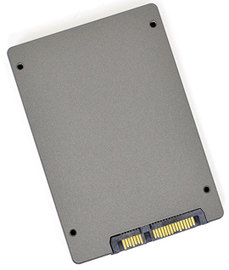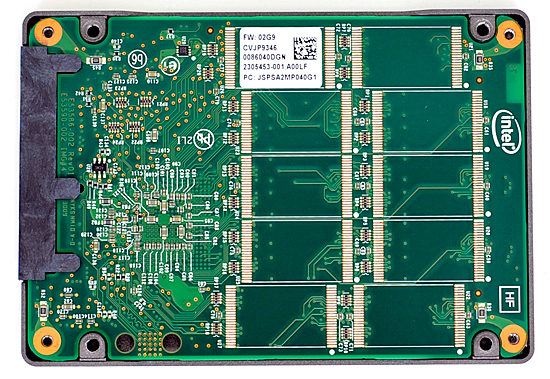The SSD Improv: Intel & Indilinx get TRIM, Kingston Brings Intel Down to $115
by Anand Lal Shimpi on November 17, 2009 7:00 PM EST- Posted in
- Storage
Kingston Delivers the First Good Sub-$100 SSD (after Rebate)
I’m not sure what sort of sweetheart deal Intel inked with Kingston, but it’s paying off. Other than Hitachi, Kingston is the only company allowed to use Intel’s controllers in their SSDs. And today, it gets even more interesting. The Kingston SSDNow V Series 40GB Boot Drive is a 34nm X25-M G2 with only 40GB of MLC NAND Flash on it.


You read that right, Kingston gets to make a 40GB X25-M G2 under its own brand.
Kingston wants this to be specifically used for your OS and applications, where the speedy launch performance of an SSD is most useful. You’d keep your games, data and other large files on a separate hard drive. Why 40GB? To keep costs down of course. The Kingston drive goes on sale starting November 9th. The MSRP of the drive will be $115 ($130 with a 2.5” to 3.5” drive adapter), Kingston is offering a rebate through Newegg that will apparently drop the price to $84.99.
Kingston’s goal was to hit the sub-$100 price point and they did it, sort of. I’m not a big fan of mail-in rebates, and it remains to be seen if Newegg can keep the drive in stock at those prices, but the intention is good.

Only 5 devices means the Intel controller works in 5-channel mode, instead of 10-channel like the X25-M G2
While the drive uses an Intel 34nm X25-M controller and 34nm flash, it doesn’t have the latest firmware from Intel, which means it doesn’t support TRIM. Since it’s technically not an Intel drive you can’t update it using the firmware I linked to earlier. The drive will most likely eventually get TRIM support, just not now. Unfortunately it doesn't even work with Intel's SSD Toolbox, again, because it's technically a Kingston drive.

With only half the NAND flash of an 80GB X25-M (only five NAND devices on board), its sequential write speeds are cut in half - Kingston rates the drive at 40MB/s. Random performance suffers a bit, but sequential write performance sees the biggest hit.
If you've already got a large hard drive for games/data and don't have that many apps installed, the Kingston 40GB SSD is a perfect way to move to an SSD affordably.










162 Comments
View All Comments
mbreitba - Tuesday, October 27, 2009 - link
Looks like a lot of people are having problems with it, and Intel has pulled it :http://communities.intel.com/thread/7693?start=45&...">http://communities.intel.com/thread/7693?start=45&...
Griswold - Wednesday, October 28, 2009 - link
If you actually look at the number of people with the issue and filter out the chit-chat, its not "alot" actually. However, my flash went just fine.Thats the risk with flashing firmware regardless of what device it is. Theres always the chance to brick it. Thats also why I dont understand why some people flash every fucking piece of hardware whenever theres a new firmware available - ok, this is a different case, here it makes perfectly sense.
strikeback03 - Wednesday, October 28, 2009 - link
Has anyone had problems flashing a drive before they put any data on it? I have a new G2 still in the box that I just haven't yet had time to do anything with, was planning on flashing it then loading Win7 and Ubuntu 9.10 this weekend, have there been any reports of issues when loading an OS after flashing?UltraWide - Tuesday, October 27, 2009 - link
Great article, I like the definite conclusions and recommendations. Keep up the good work!nicolasv - Tuesday, October 27, 2009 - link
Hi AnandIn 'The SSD Relapse' you state that the G2 "doesn't drop in performance when used...at all." Yet in 'The SSD Improv' the 80GB G2 with TRIM firmware drops more than 60% in the 4KB random write test.
Granted, the charts and figures used in 'Relapse' to back its claim are for the 160GB G2 and these results are for the 80GB G2. What do you attribute this difference in performance to, the new TRIM firmware?
As a Mac OS X user, at this point, I feel like I can only really consider drives that perform well without TRIM, especially in the <= 80GB range, so would appreciate your feedback.
Cheers
Nicolas
7Enigma - Tuesday, October 27, 2009 - link
I believe it is because in that particular test he is writing to the ENTIRE 80gig drive, so it's not that TRIM isn't working per se, rather that there is no free space to allow TRIM to do anything at all.7Enigma - Tuesday, October 27, 2009 - link
As an addendum to my previous post, you can see that after file deletion the performance goes back to virtually new. So in a sense the performance of the drive never goes down, UNLESS you simply delete a partition rather than erasing the data on that partition FIRST and then deleting it.I think that's probably something that needs to be implemented with an updated driver, or at least a warning box that comes up saying "deleting this partition without formatting will hinder performance".
GullLars - Tuesday, October 27, 2009 - link
I don't know if you have done extensive benchmarking with SSDs, but using IO QD = 3 for 4KB random in IOmeter don't yield representative results for intels SSDs. I have been benchmarking SSDs with some other guys for over a year now, and we have found that while Samsung and Indilinx scale from QD 1-4 and then flat out, Intels x25-M scales well all the way to around QD 10-16, and actually is capable of over 140 MB/s at 4KB random read at QD=64 in fresh state, and still over double your messured 60-64 MB/s in used state.In our benchmark thread, the records with x25-M from ICH10R before TRIM firmware are:
IOmeter
4KB random read QD=64: 40913 IOPS = 163,5 MB/s
4KB random write QD=64: 19360 IOPS = 77 MB/s
PCmark vantage HDD score: 43107.
The same guy that got the random read and PCmark scores above also got PCmark vantage HDD score 120374 with 3 x25-M gen1 from ICH10R.
In other words, the results posted for x25-M in this review are either in "used state" or below par.
Voo - Tuesday, October 27, 2009 - link
You know Anand trys to simulate REAL situations and a QD of 10-16 is absolutly unrealistic for a home user - don't even talk about a QD of 64. Maybe the Intel SSDs shine there, but it's just of no interest.GullLars - Tuesday, October 27, 2009 - link
In his traced "light" benchmark with mostly single-tasking the average queue depth is 6.09. If you take into account that most of the sequential read and write operations (although they are under 30%) don't generate a queue, and that 4-16KB IOs often come in bursts with more queue depth, you can easily get a QD of more than 10 with relatively mild multitasking if it involves disk access. A harddisk's cache is regulary used as a buffer for the write portion of these, but if the cache is full your system almost freezes because of the harddisks low IOPS. An example would be if you try installing windows updates or a program while running a virus scan and listening to music or extracting a compressed archive, you will quickly notice if you try this on a harddisk.